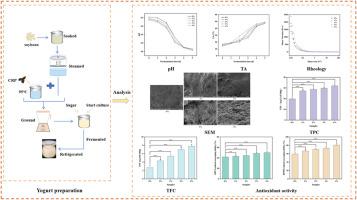Effects of Citri Reticulatae Pericarpium on the physicochemical, rheological, and sensory properties of soy yogurt
IF 6.6
1区 农林科学
Q1 FOOD SCIENCE & TECHNOLOGY
引用次数: 0
Abstract
This study investigated the effects of Citri Reticulatae Pericarpium (CRP) addition on the physicochemical properties, rheological characteristics, microstructure, flavor, antioxidant activity and sensory properties of soy yogurt. Adding 2 %–4 % CRP significantly accelerated the acid production rate of lactic acid bacteria, reducing pH to 4.56 and improving titratable acidity to 49.01°T of yogurt. Moderate addition of CRP (1 %–2 %) can enhance the textural and rheological properties of the yogurt, especially increasing the hardness, adhesiveness, springiness and chewiness to 0.60 N, 1.10 N mm, 10.13 mm and 2.57 mj, while over 4 % harmed the gel structure and rheology. SEM revealed that 1 %–3 % CRP addition enhanced gel compactness, consistent with textural and rheological analysis results. Moreover, CRP significantly enhanced the content of total phenol and flavonoid to 32.02 mg GAE/100g and 7.80 mg RE/100g, respectively, significantly boosting the antioxidant activity of the soy yogurt. Flavor analysis demonstrated that CRP effectively masked the beany flavor. Particularly at a 2 % addition, volatile compounds with floral and sweet aroma were detected. Sensory evaluation conducted by trained panels indicated that 2 % CRP addition had the highest overall acceptance score of 7.35. These findings provide valuable insights for the development of functional plant-based yogurt.

柑桔皮对大豆酸奶理化、流变学和感官特性的影响
研究了添加柠檬酸皮(CRP)对大豆酸奶理化性质、流变特性、微观结构、风味、抗氧化活性和感官特性的影响。添加2% ~ 4% CRP可显著加快乳酸菌的产酸速度,使酸奶的pH降至4.56,可滴定酸度提高至49.01°T。适量添加CRP(1% ~ 2%)可增强酸奶的质地和流变性能,特别是使酸奶的硬度、黏附性、弹性和嚼劲分别提高到0.60 N、1.10 N mm、10.13 mm和2.57 mj,而添加4%以上的CRP则会损害酸奶的凝胶结构和流变性能。扫描电镜显示,添加1% - 3%的CRP增强了凝胶致密性,与结构和流变学分析结果一致。此外,CRP显著提高了大豆酸奶的总酚和类黄酮含量,分别达到32.02 mg GAE/100g和7.80 mg RE/100g,显著提高了大豆酸奶的抗氧化活性。风味分析表明,CRP有效地掩盖了豆味。特别是在添加2%时,检测到具有花香和甜味的挥发性化合物。通过训练小组进行的感官评估表明,2% CRP的添加具有最高的总体接受评分7.35。这些发现为功能性植物酸奶的开发提供了有价值的见解。
本文章由计算机程序翻译,如有差异,请以英文原文为准。
求助全文
约1分钟内获得全文
求助全文
来源期刊

LWT - Food Science and Technology
工程技术-食品科技
CiteScore
11.80
自引率
6.70%
发文量
1724
审稿时长
65 days
期刊介绍:
LWT - Food Science and Technology is an international journal that publishes innovative papers in the fields of food chemistry, biochemistry, microbiology, technology and nutrition. The work described should be innovative either in the approach or in the methods used. The significance of the results either for the science community or for the food industry must also be specified. Contributions written in English are welcomed in the form of review articles, short reviews, research papers, and research notes. Papers featuring animal trials and cell cultures are outside the scope of the journal and will not be considered for publication.
 求助内容:
求助内容: 应助结果提醒方式:
应助结果提醒方式:


